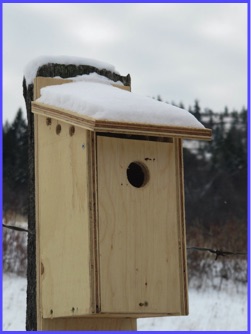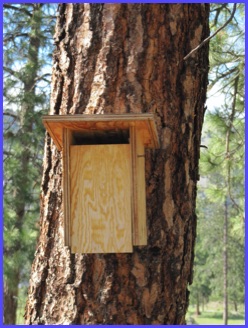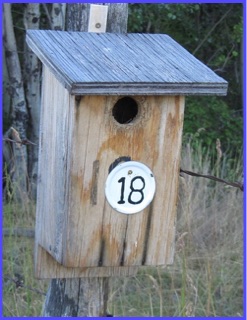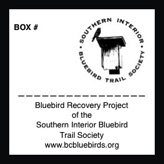BLUEBIRDS are secondary cavity nesters, which means they need a hole or cavity that something else has excavated. In nature it is often the abandoned woodpecker cavity that the bluebird uses to nest in. Bluebirds and woodpecker population trends go hand in hand. When natural cavities are lacking, humans can provide a nestbox to encourage them to nest.
Mountain and Western bluebirds prefer open spaces with scattered trees and low sparse vegetation. They can be found in open farmland, orchards, forest edges, golf courses, cemeteries and desert-like areas. Successful nesting is based on putting the nestbox in the right habitat.
Bluebirds prefer a certain size and dimension of nest cavity. The opening to get into the box or cavity is also important. The Johnson slot nestbox accommodates all three species of bluebirds, which includes Eastern, Western and the Mountain Bluebird. It has been tested and approved for this use by the North American Bluebird Society. The slot opening is 1-3/16 inches. It has a saw kerf under the roof to direct water away from the entrance and has plenty of ventilation for warm environments.
In boxes with a round hole, the hole must be 1-9/16 inches. There are various box designs, each with their advocates. Some have a hinged roof for top-opening, while others open on a side or the front.
Designs cans be found on the North American Bluebird Society website, as well other online references, and in the booklet Mountain Bluebird Trail Monitoring Guide, by Myrna Pearman. Boxes can even be purchased from stores and online sources, but be sure to buy one with the 1-9/16 inch hole.
If building boxes yourself is not an option, consider school carpentry classes, seniors clubs, scouts, and other community groups.
Boxes are mounted at eye level for easy monitoring. They can be mounted on fences or trees, however it is ideal to have a dedicated pole for each box. Mount them so they face away from prevailing winds and are shaded from hot afternoon sun. When the young make their first flight (fledge) to safety, they fly about 100 feet so face the box toward a tree, shrub or post in the distance. Never put boxes on utility poles or on private property unless you have obtained permission from the owner.
If you have predators such as raccoons, snakes, cats, chipmunks, squirrels or bears you may have to use special precautions. It is generally recommended not to put up nestboxes in an area where there are cats because bluebirds feed by catching insects on the ground and may be easy prey for felines.
Predator guards can be used on poles below the nestbox or on entrances to protect bluebirds.
Spacing of boxes - Spacing of about 300 to 400 feet apart is about right to provide enough area for the bluebird to search for food in. However if swallows use the boxes, pairing the boxes 15 to 20 feet apart may allow the bluebird and the swallow to nest side by side. One theory suggests that a tree or violet green swallow will evict a bluebird unless there are two boxes available. There do not seem to be any theories regarding other cavity nesters such as nuthatches and chickadees and their relationship with bluebirds. Recently one person noted that an American Kestrel and bluebird family nested successfully in boxes on the same post. You have to be willing to experiment a little by adding and deleting boxes depending on the situation.
Since the Johnson Slot box has a roof overhang on all sides, a piece of 2X4 (7inches long, with one end cut on an angle) is nailed to the tree or fencepost first (with the sloping edge away from the box) using two 4 inch box nails. The nestbox is then attached to the 2x4 with two #12 21/2-inch wood screws, leaving the top back air vent clear of the 2x4. This prevents the box from sloping forward and keeps the floor level.
The finishing touch might be putting a handful of preservative-free coarse wood shavings in the box - making it more like a natural tree cavity.


above: a nestbox with a round hole
This design is front-opening, with the hinge at the top of the front panel. Also note the ventilation holes at the top, on the sides.
above: a Johnson slot box

Boxes should be numbered, to aid record keeping. Numbers can be painted on or written with an ink marker (this fades quickly). Painted metal disks, as shown, are another option.
BC Bluebirds also sells "plastic paper" tags (shown below), which can be stapled to the box and a number written or painted on the tag. They are available for $5.00 for 10.
